Abstract
The effect of a pretreatment with phenobarbitone (PB) on the porphyrinogenic action exerted by hexachlorobenzene (HCB) was examined in female rats. Kinetic studies of enzyme function after HCB poisoning showed that porphyrinogen carboxy-lyase was the only enzyme of haem biosynthesis that markedly lowered its activity. Both stages of uroporphyrinogen (UPG) III decarboxylation were decreased. This enzyme, together with UPG I synthase (increased levels) were the first enzymes altered. Subsequently, an increase in delta-aminolaevulinate (AmLev) synthase and ferrochelatase was detected; AmLev dehydratase was the last to increase. On long-term exposure, PB alone did not modify the basal values of haem intermediates; only the content of cytochrome P-450 increased. All the enzyme activities studied showed no significant changes, except ferrochelatase, which increased. With both drugs the metabolic impairment promoted by HCB was accelerated and enhanced by prior PB treatment leading to the onset of an earlier and stronger porphyria. A more noticeable accumulation and excretion of higher carboxylated porphyrins and precursors was more promptly observed as a consequence of the early porphyrinogen carboxy-lyase blockade and the concomitant induction of AmLev synthase. Although the enzymic activities of both AmLev dehydratase and ferrochelatase were enhanced, this response differed in time. For UPG I synthase this pretreatment elicited lower values than those found in the HCB group. Cytochrome P-450 contents were immediately and slightly enhanced by all the drugs, but the values for the combined treatment were the lowest. Of the several hypotheses that could explain the action of HCB on the haem pathway, our results would suggest that the porphyrinogenic action of HCB is mediated by some of its metabolic products.
Full text
PDF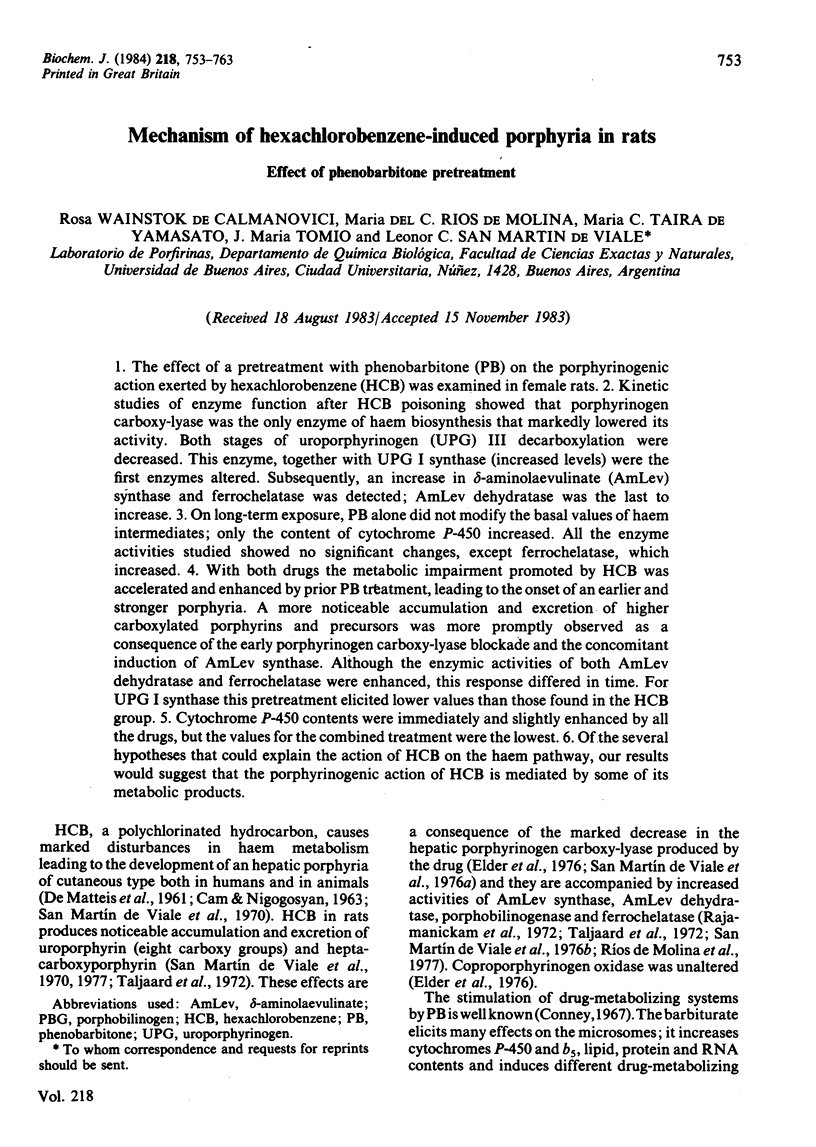
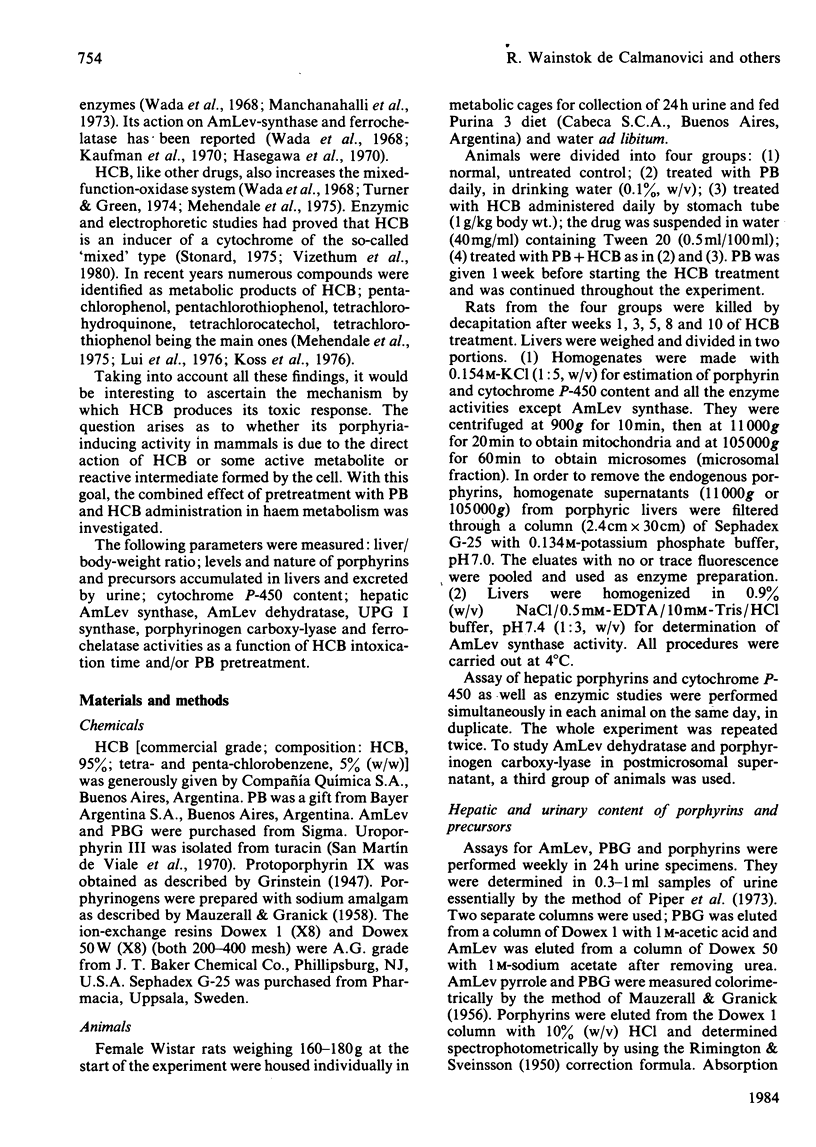
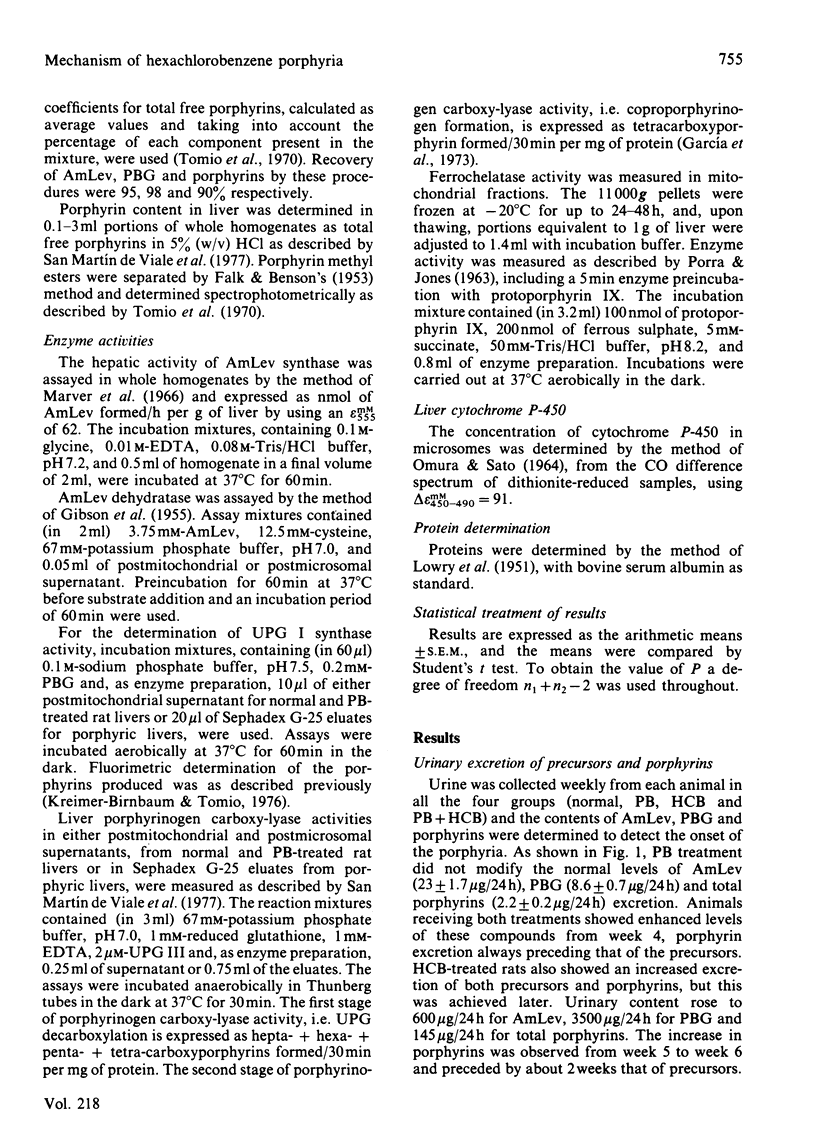
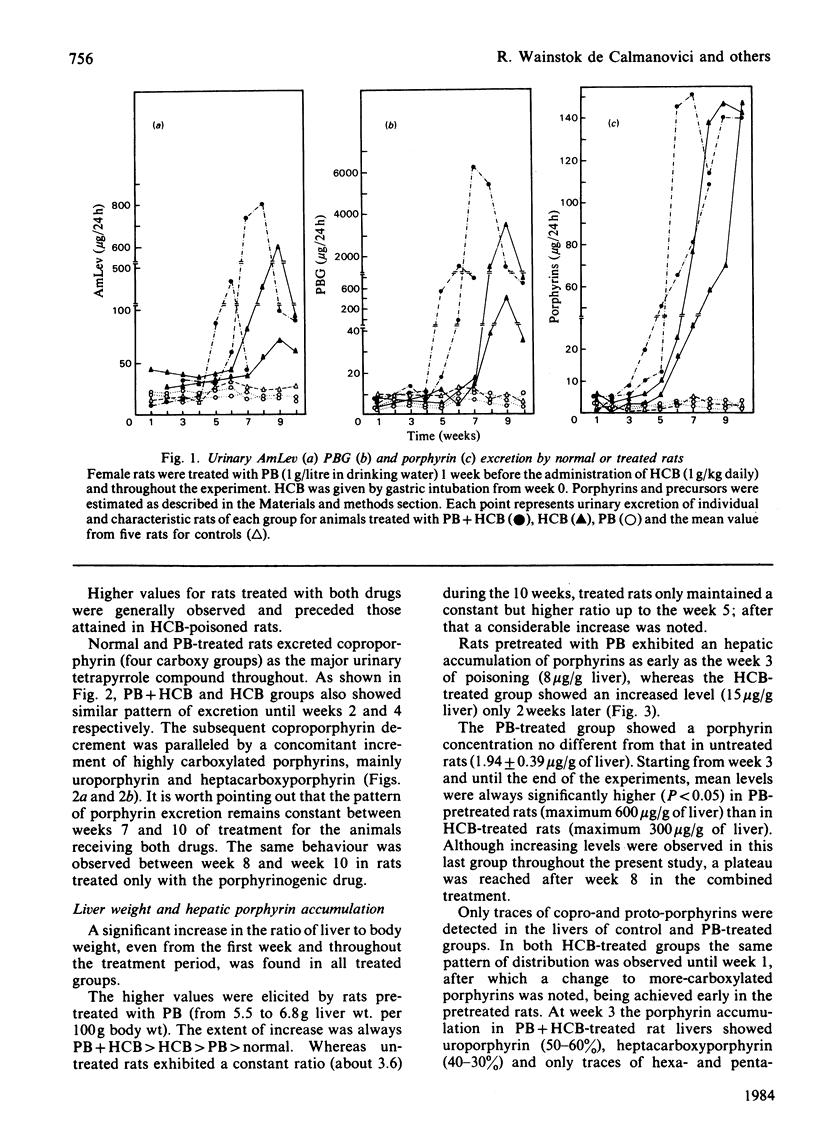
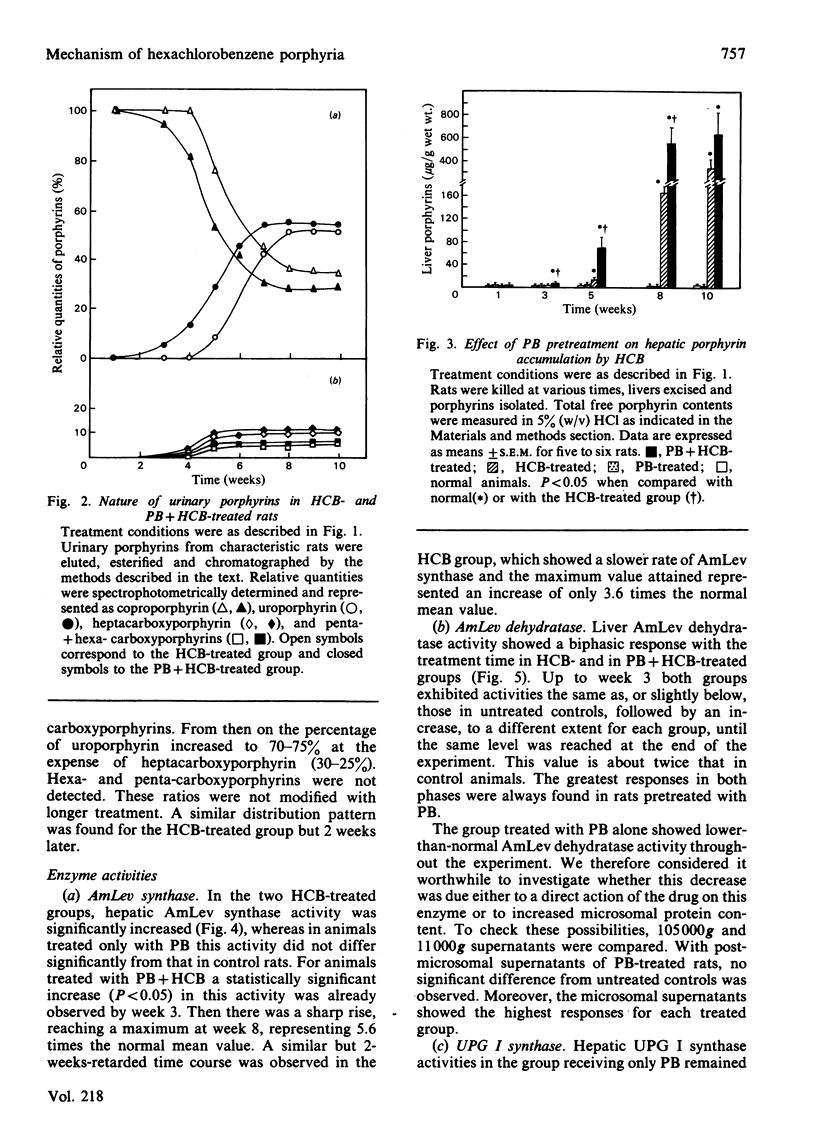
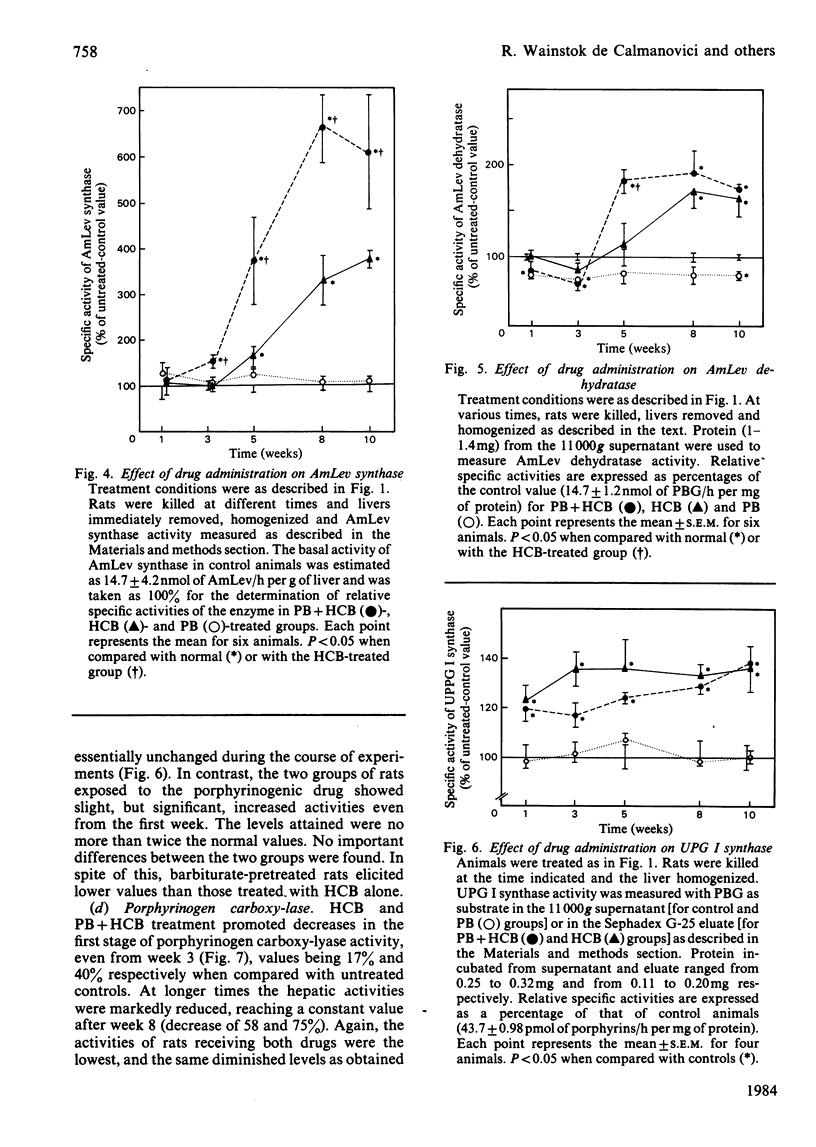
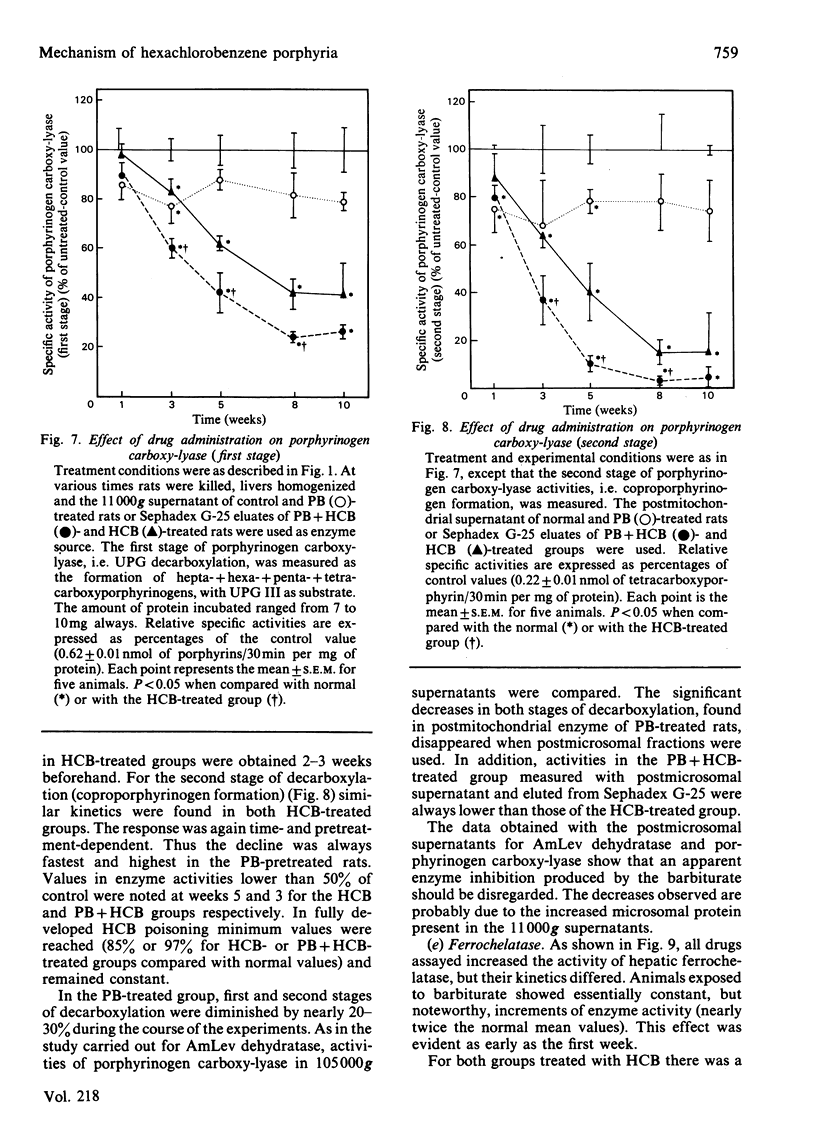
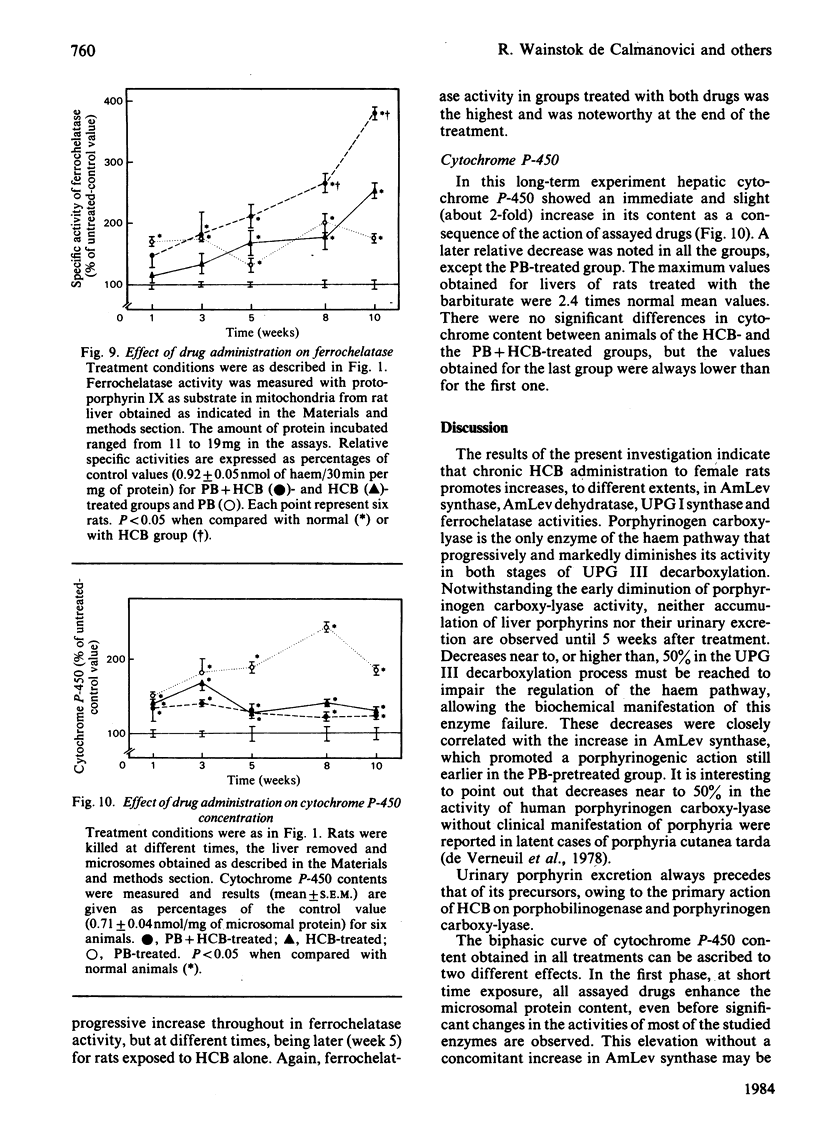
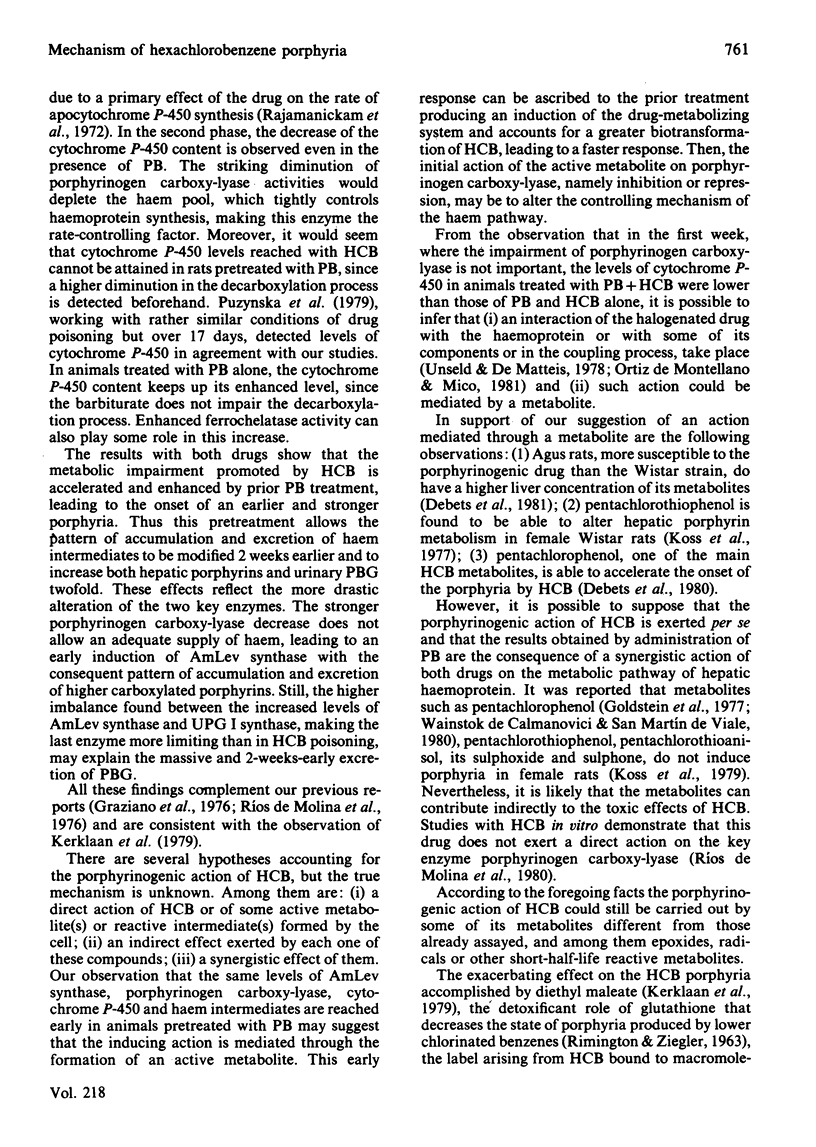
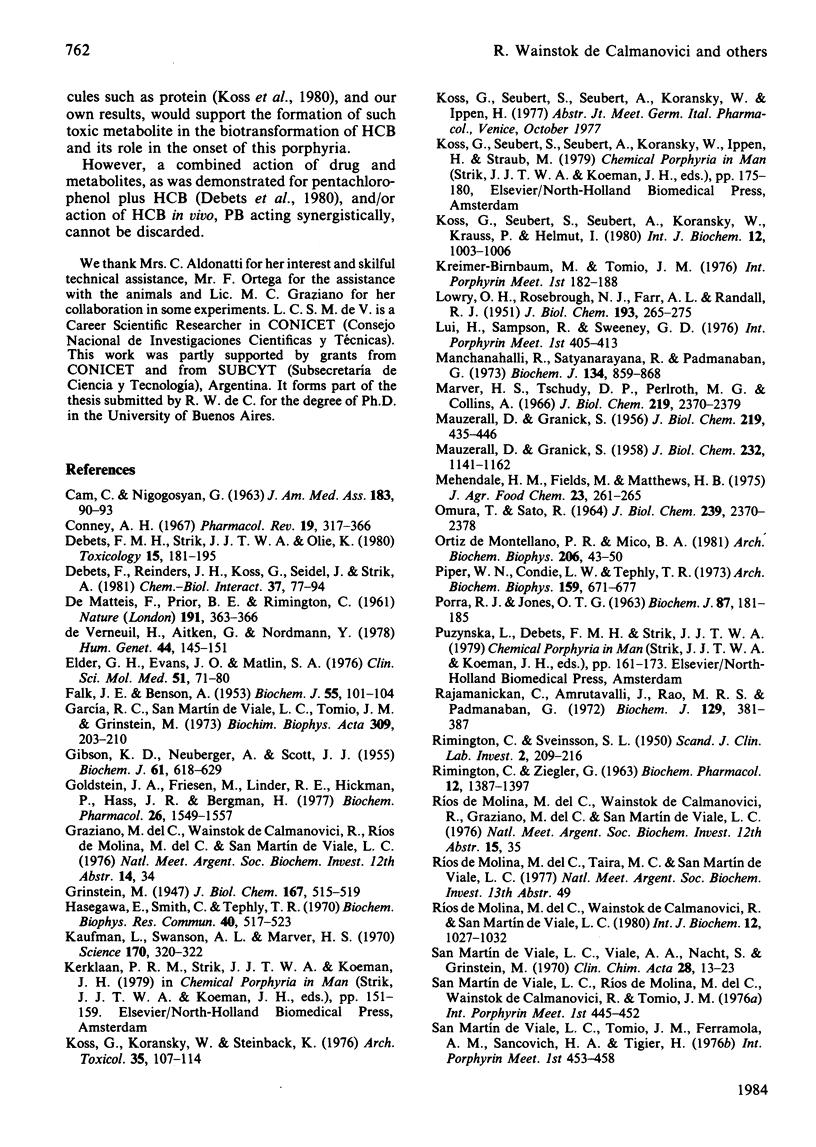
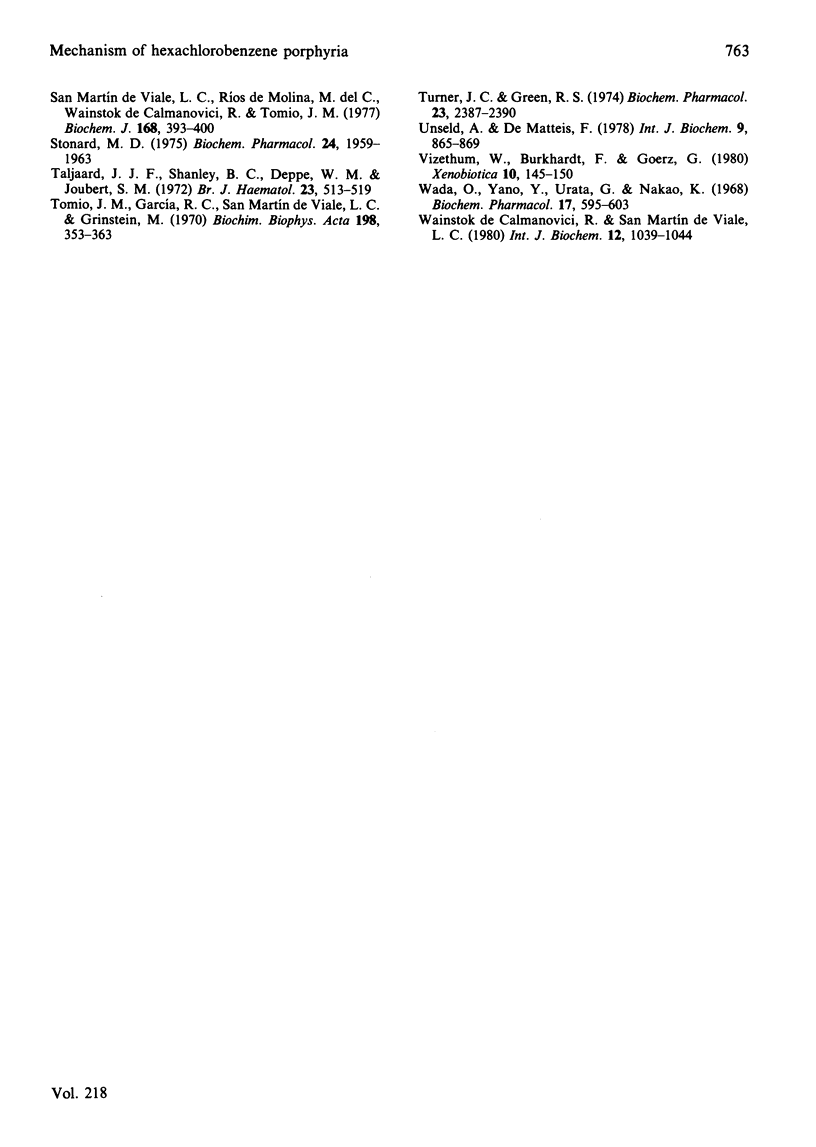
Selected References
These references are in PubMed. This may not be the complete list of references from this article.
- Conney A. H. Pharmacological implications of microsomal enzyme induction. Pharmacol Rev. 1967 Sep;19(3):317–366. [PubMed] [Google Scholar]
- DE MATTEIS F., PRIOR B. E., RIMINGTON C. Nervous and biochemical disturbances following hexachlorobenzene intoxication. Nature. 1961 Jul 22;191:363–366. doi: 10.1038/191363a0. [DOI] [PubMed] [Google Scholar]
- Debets F. M., Strik J. J., Olie K. Effects of pentachlorophenol on rat liver changes induced by hexachlorobenzene, with special reference to porphyria, and alterations in mixed function oxygenases. Toxicology. 1980;15(3):181–195. doi: 10.1016/0300-483x(80)90052-9. [DOI] [PubMed] [Google Scholar]
- Debets F., Reinders J. H., Koss G., Seidel J., Strik A. Effects of dietary antioxidants on the biotransformation and porphyrinogenic action of hexachlorobenzene in two strains of rats. Chem Biol Interact. 1981 Oct;37(1-2):77–94. doi: 10.1016/0009-2797(81)90167-8. [DOI] [PubMed] [Google Scholar]
- Elder G. H., Evans J. O., Matlin S. A. The effect of the porphyrogenic compound, hexachlorobenzene, on the activity of hepatic uroporphyrinogen decarboxylase in the rat. Clin Sci Mol Med. 1976 Jul;51(1):71–80. doi: 10.1042/cs0510071. [DOI] [PubMed] [Google Scholar]
- FALK J. E., BENSON A. Separation of uroporphyrin esters I and III by paper chromatography. Biochem J. 1953 Aug;55(1):101–104. [PMC free article] [PubMed] [Google Scholar]
- GIBSON K. D., NEUBERGER A., SCOTT J. J. The purification and properties of delta-aminolaevulic acid dehydrase. Biochem J. 1955 Dec;61(4):618–629. doi: 10.1042/bj0610618. [DOI] [PMC free article] [PubMed] [Google Scholar]
- Garcia R. C., San Martin de Viale L. C., Tomio J. M., Grinstein M. Porphyrin biosynthesis. X. Porphyrinogen carboxy-lyase from avian erythrocytes: further properties. Biochim Biophys Acta. 1973 May 5;309(1):203–210. doi: 10.1016/0005-2744(73)90332-x. [DOI] [PubMed] [Google Scholar]
- Goldstein J. A., Friesen M., Linder R. E., Hickman P., Hass J. R., Bergman H. Effects of pentachlorophenol on hepatic drug-metabolizing enzymes and porphyria related to contamination with chlorinated dibenzo-p-dioxins and dibenzofurans. Biochem Pharmacol. 1977 Sep 1;26(17):1549–1557. doi: 10.1016/0006-2952(77)90068-5. [DOI] [PubMed] [Google Scholar]
- Hasegawa E., Smith C., Tephly T. R. Induction of hepatic mitochondrial ferrochelatase by phenobarbital. Biochem Biophys Res Commun. 1970 Aug 11;40(3):517–523. doi: 10.1016/0006-291x(70)90932-0. [DOI] [PubMed] [Google Scholar]
- Kaufman L., Swanson A. L., Marver H. S. Chemically induced porphyria: prevention by prior treatment with phenobarbital. Science. 1970 Oct 16;170(3955):320–322. doi: 10.1126/science.170.3955.320. [DOI] [PubMed] [Google Scholar]
- Koss G., Koransky W., Steinbach K. Studies on the toxicology of hexachlorobenzene. II. Identification and determination of metabolites. Arch Toxicol. 1976 Mar 11;35(2):107–114. doi: 10.1007/BF00372764. [DOI] [PubMed] [Google Scholar]
- Koss G., Seubert S., Seubert A., Koransky W., Kraus P., Ippen H. Conversion products of hexachlorobenzene and their role in the disturbance of the porphyrin pathway in rats. Int J Biochem. 1980;12(5-6):1003–1006. doi: 10.1016/0020-711x(80)90202-5. [DOI] [PubMed] [Google Scholar]
- LOWRY O. H., ROSEBROUGH N. J., FARR A. L., RANDALL R. J. Protein measurement with the Folin phenol reagent. J Biol Chem. 1951 Nov;193(1):265–275. [PubMed] [Google Scholar]
- MAUZERALL D., GRANICK S. Porphyrin biosynthesis in erythrocytes. III. Uroporphyrinogen and its decarboxylase. J Biol Chem. 1958 Jun;232(2):1141–1162. [PubMed] [Google Scholar]
- MAUZERALL D., GRANICK S. The occurrence and determination of delta-amino-levulinic acid and porphobilinogen in urine. J Biol Chem. 1956 Mar;219(1):435–446. [PubMed] [Google Scholar]
- Mehendale H. M., Fields M., Mathews H. B. Metabolism and effects of hexachlorobenzene on hepatic microsomal enzymes in the rat. J Agric Food Chem. 1975 Mar-Apr;23(2):261–265. doi: 10.1021/jf60198a042. [DOI] [PubMed] [Google Scholar]
- OMURA T., SATO R. THE CARBON MONOXIDE-BINDING PIGMENT OF LIVER MICROSOMES. I. EVIDENCE FOR ITS HEMOPROTEIN NATURE. J Biol Chem. 1964 Jul;239:2370–2378. [PubMed] [Google Scholar]
- Ortiz de Montellano P. R., Mico B. A. Destruction of cytochrome P-450 by allylisopropylacetamide is a suicidal process. Arch Biochem Biophys. 1981 Jan;206(1):43–50. doi: 10.1016/0003-9861(81)90063-1. [DOI] [PubMed] [Google Scholar]
- PORRA R. J., JONES O. T. Studies on ferrochelatase. 1. Assay and properties of ferrochelatase from a pig-liver mitochondrial extract. Biochem J. 1963 Apr;87:181–185. doi: 10.1042/bj0870181. [DOI] [PMC free article] [PubMed] [Google Scholar]
- RIMINGTON C., SVEINSSON S. L. The spectrophotometric determination of uroporphyrin. Scand J Clin Lab Invest. 1950;2(3):209–216. doi: 10.3109/00365515009049872. [DOI] [PubMed] [Google Scholar]
- RIMINGTON C., ZIEGLER G. EXPERIMENTAL PORPHYRIA IN RATS INDUCED BY CHLORINATED BENZENES. Biochem Pharmacol. 1963 Dec;12:1387–1397. doi: 10.1016/0006-2952(63)90208-9. [DOI] [PubMed] [Google Scholar]
- Rajamanickam C., Amrutavalli J., Rao M. R., Padmanaban G. Effect of hexachlorobenzene on haem synthesis. Biochem J. 1972 Sep;129(2):381–387. doi: 10.1042/bj1290381. [DOI] [PMC free article] [PubMed] [Google Scholar]
- Rao M. R., Padmanaban G. Biochemical effects of the porphyrinogenic drug allylisopropylacetamide. A comparative study with phenobarbital. Biochem J. 1973 Aug;134(4):859–868. doi: 10.1042/bj1340859. [DOI] [PMC free article] [PubMed] [Google Scholar]
- Rios de Molina M. C., Wainstok de Calmanovici R., San Martin de Viale L. C. Investigations on the presence of porphyrinogen carboxy-lyase inhibitor in the liver of rats intoxicated with hexachlorobenzene. Int J Biochem. 1980;12(5-6):1027–1032. doi: 10.1016/0020-711x(80)90206-2. [DOI] [PubMed] [Google Scholar]
- San Martin de Viale L. C., Viale A. A., Nacht S., Grinstein M. Experimental porphyria induced in rats by hexachlorobenzene. A study of the porphyrins excreted by urine. Clin Chim Acta. 1970 Apr;28(1):13–23. doi: 10.1016/0009-8981(70)90155-5. [DOI] [PubMed] [Google Scholar]
- San Martín De Viale L. C., Ríos De Molina M. D., De Calmanovici R. W., Tomio J. M. Porphyrins and porphyrinogen carboxy-lase in hexachlorobenzene-induced porphyria. Biochem J. 1977 Dec 15;168(3):393–400. doi: 10.1042/bj1680393. [DOI] [PMC free article] [PubMed] [Google Scholar]
- Stonard M. D. Mixed type hepatic microsomal enzyme induction by hexachlorobenzene. Biochem Pharmacol. 1975 Nov 1;24(21):1959–1963. doi: 10.1016/0006-2952(75)90382-2. [DOI] [PubMed] [Google Scholar]
- Taljaard J. J., Shanley B. C., Deppe W. M., Joubert S. M. Prophyrin metabolism in experimental hepatic siderosis in the rat. II. Combined effect of iron overload and hexachlorobenzene. Br J Haematol. 1972 Oct;23(4):513–519. doi: 10.1111/j.1365-2141.1972.tb07086.x. [DOI] [PubMed] [Google Scholar]
- Tomio J. M., García R. C., San Martín de Viale L. C., Grinstein M. Porphyrin biosynthesis. VII. Porphyrinogen carboxy-lyase from avian erythrocytes. Purification and properties. Biochim Biophys Acta. 1970 Feb 11;198(2):353–363. doi: 10.1016/0005-2744(70)90068-9. [DOI] [PubMed] [Google Scholar]
- Turner J. C., Green R. S. Effect of hexachlorobenzene on microsomal enzyme systems. Biochem Pharmacol. 1974 Sep 1;23(17):2387–2390. doi: 10.1016/0006-2952(74)90228-7. [DOI] [PubMed] [Google Scholar]
- Unseld A., de Matteis F. Destruction of endogenous and exogenous haem by 2-allyl-2-isopropylacetamide: role of the liver cytochrome P-450 which is inducible by phenobarbitone. Int J Biochem. 1978;9(12):865–869. doi: 10.1016/0020-711x(78)90061-7. [DOI] [PubMed] [Google Scholar]
- Vizethum W., Burkhardt F., Goerz G. Enzymic and electrophoretic characterization of the hexachlorobenzene-induced cytochrome P-450 in the liver of rat. Xenobiotica. 1980 Feb;10(2):145–150. doi: 10.3109/00498258009033740. [DOI] [PubMed] [Google Scholar]
- Wada O., Yano Y., Urata G., Nakao K. Behavior of hepatic microsomal cytochromes after treatment of mice with drugs known to disturb porphyrin metabolism in liver. Biochem Pharmacol. 1968 Apr;17(4):595–603. doi: 10.1016/0006-2952(68)90275-x. [DOI] [PubMed] [Google Scholar]
- Wainstok de Calmanovici R., San Martin de Viale L. C. Effect of chlorophenols on porphyrin metabolism in rats and chick embryo. Int J Biochem. 1980;12(5-6):1039–1044. doi: 10.1016/0020-711x(80)90208-6. [DOI] [PubMed] [Google Scholar]
- de Verneuil H., Aitken G., Nordmann Y. Familial and sporadic porphyria cutanea: two different diseases. Hum Genet. 1978 Oct 31;44(2):145–151. doi: 10.1007/BF00295407. [DOI] [PubMed] [Google Scholar]


